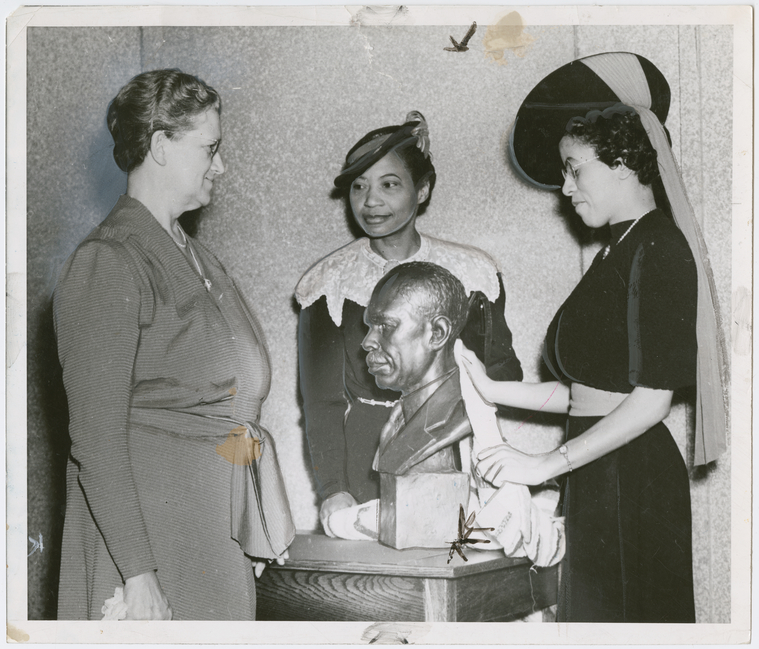NYPL's Ernestine Rose: Opening the Door to Diversity
In honor of Women's History Month, the Library is taking a look back at some of the remarkable women who changed The New York Public Library—and the field of librarianship—forever with our new series, Foreword: Women Who Built NYPL. Each week this March, we will be sharing reflections from our current staff on how the impact of these trailblazing figures from the Library's 125-year history are still felt today.
About Ernestine Rose
Ernestine Rose began her Library career at the Bloomingdale branch in 1905 and made her reputation for working closely with communities at Chatham Square and Seward Park. After a brief stint away from the Library, she was brought back in 1920 with a mandate to hire Black librarians, and replicate the community work she did on the Lower East Side, at the 135th Street Library in Harlem, a center of Black life in the city. Her first hire was Catherine Allen Latimer, the Library’s first Black librarian, who was instrumental in building collections documenting the Black experience at the 135th Street Library (a collection that eventually became the Schomburg Center for Research in Black Culture). Rose went on to make important first steps in integrating the Library and making it more supportive of communities of color—though there was still much to do and many decades of work ahead. Rose hired five of the librarians on this list—including trailblazing librarians Latimer, Jean Blackwell Hutson, Pura Belpré, and Regina Andrews, and the first female head of NYPL’s branches, Esther K. Johnston.
Ernestine Rose’s Legacy
Reflection by Nicole Nelson, Library Manager, Countee Cullen Library
I’ve read up on Ernestine Rose, and I used the Library’s databases and resources to find out more about her. I read this one article, "A White Librarian in Black Harlem," about all the work that Rose did to bring attention to the fight and the plight of the African American people during the 1920s, to encourage reading, to encourage working together with the community. That’s something that we’re still striving to do at Countee Cullen: to bridge the gap with the community and the Library. She paved the way for many of us. If it wasn’t for her, I don’t think I would be able to be in this position that i’m in today. I’m grateful to her for opening doors for African American women to come into the Library and shape it.
I came to the Library in 1995 as a page at the Donnell Library Center in the central children’s room. I just came to the Library to earn money to put in my pocket after school. I never thought I would still be here 25 years later. I majored in computer science, that was my thing, but I felt like dealing with computers was so not me. I like to be around people. I like to talk. I like helping people. And this is why I stuck with the Library. I wanted to help people and bring joy to people’s lives, because I feel like reading opens the door for anything.
The first time you help a person, it’s like a drug. You just want to go out and help everybody! Especially when it’s little kids and you give them their first library card—you see the excitement on their face. I wish I could give cards to kids all day.
Ernestine Rose stated that the library should stimulate and guide the culture. And that’s something that we continue to do here. We have a Black Experience collection that you’re not going to find anywhere else but at the Countee Cullen Library. My goal is to make sure our Black Experience collection reflects and documents the lives of Black people in the U.S. and abroad. It started out as an adult collection, but as I heard parents and teens talking, I thought, we need to expand this collection. It started out with maybe 20 books on the shelf—I think now we have 600 books. It extends through the whole building and reaches all age ranges. We have a Black Experience collection for children. We have a Black Experience collection for teens.
When you see the kids, and they open up a book and see a character that looks like them, they’re so excited, so amazed. They want to tell everybody, “This character looks like me.” I helped a little girl last week find a book with a Black grandmother and a Black granddaughter, and she goes, “I’m going to call my grandma when I get home and show her the book. It looks like me and grandma when we spend time together.” And her mother said, “Thank you, you don’t know what this means to me and what this means to my daughter and my mom.” It brought a tear to my eye, because I was a part of this moment!
I want to get back to the basics of Ernestine Rose. I want to strive for what she strived for in the 1920s. I want to change the face—again—of Countee Cullen.
This is part of the Foreword: Women Who Built NYPL series. Find out how the Library is celebrating Women's History Month with recommended reading, events and programs, and more.
Read E-Books with SimplyE
 With your library card, it's easier than ever to choose from more than 300,000 e-books on SimplyE, The New York Public Library's free e-reader app. Gain access to digital resources for all ages, including e-books, audiobooks, databases, and more.
With your library card, it's easier than ever to choose from more than 300,000 e-books on SimplyE, The New York Public Library's free e-reader app. Gain access to digital resources for all ages, including e-books, audiobooks, databases, and more.
If you don’t have an NYPL library card, New York State residents can apply for a digital card online or through SimplyE (available on the App Store or Google Play).
Need more help? Read our guide to using SimplyE.
